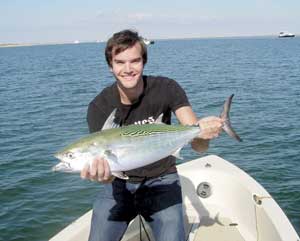
Since the beginning of time, creatures of all shapes have roamed the earth by land and sea. The basic instincts exhibited by all animals within the pyramid of life are shaped and formed through cause-and-effect relationships between species and among species throughout their surroundings.
Environmental pressures control every speckled trout along the South Carolina coast and influence their feeding schedules and movements. The environmental factors that affect wildlife are mostly specific to their habitats, such as the feeding habits of fish.
These habits are determined by a collection of effects including: photoperiod, lunar influence, tides, water temperature, current, water clarity, boat traffic, fishing pressure, and barometric pressure. Many of the environmental effects tend to make sense, but barometric pressure seems silly, unconnected, and only important to someone with a meteorology degree.
Humans do not readily recognize the effects on barometric pressure on our lives. We left our primitive lives long ago, and most of the environmental pressures are consistent with other man-induced pressures.
However, the effects of barometric pressure play a major role in the habits and responses of fish and wildlife. Knowing how to read the fluctuation of barometric pressure and how it relates to fish behavior can greatly increase the chances of having a successful or unsuccessful day on the water.
Barometric or atmospheric pressure, in a practical sense, is the weight of air. It is measured by the fluid pressure caused by the weigh of air above a measured point. The term “low pressure” refers to areas with less atmospheric mass above its location; “high pressure” areas are just the opposite. Huge air masses move around the globe in pockets, creating regions of high and low pressure. The movement of these air masses keeps the pressure gauge in a constant state of flux.
Air pressure affects fish greatly in shallow water but has little effect in deeper water. The water pressure at great depths is much stronger than any pressures exerted by the air. Fortunately for fish that live in deep water, the barometric pressure affects them the least. Most pelagic fishes are built for depths of the ocean and can withstand extreme fluctuation of pressure exerted on their bodies.
Fish have specific mechanisms to control their buoyancy, with the swim bladder No. 1. All ray-finned fish have swim bladders. In association with their gills, their swim bladders chemically convert gases from the water to the swim bladder to allow fish to move throughout the water column without burning excess energy. The swim bladder and gill system are closely related to the lungs through the mechanism of gas transfer.
Fortunately for most pelagic fishes of the deep oceans — mackerel, wahoo, tuna, and dolphin — have small swim bladders, enabling them to travel up and down the water column with ease. These fish routinely ascend and descend rapidly while chasing bait or retreating from predators. Conversely, bottom fish such as grouper, snapper, and sea bass have large swim bladders, but only frequent the habitats of the deep ocean. These fish stay close to the deep, bottom structure and gather all of their needs from well beneath the water surface, eliminating the need to ascend or descend rapidly.
Many inshore fishes, such as red drum, sheepshead, flounder, and trout, have large swim bladders and are more affected by the fluctuation of air pressure. Their inshore or nearshore waters are characteristically shallower, which increases the effects of air pressure.
Anatomically, the effects of barometric pressure can be explained through discussion on swim bladders, but how pressure completely affects fish is still not fully understood. It is believed that increased pressure on the swim bladder discomforts fish and deters feeding until the gas is equalized over a period of time or the pressure begins to fall, relieving the strain.
Learning how to read the pressure trend is the key. Generally, periods of stable pressure are the best times to fish. They are comfortable and have equalized the gases within their swim bladders to conditions.
Short periods of high pressure tend to shut down feeding, and the fishing is poor. The unexpected pressure on their bladders discomforts fish and discourages feeding. As the pressure stabilizes on the high end, feeding behavior increases. The changes in pressure itself tend to initiate spikes in feeding activity, but they may only last for a short duration. However, erratic barometric pressure will confuse and discomfort fish also discouraging feeding.
Some fish will react differently to pressure, retreating to deeper depths where the water pressure is greater than the barometric pressure near the surface. The water pressure at depth will always be more constant and more forgiving for a fish with a large swim bladder.
Catching fish sometimes seems like a complicated formula, with more variables than ever, but success will improve the more an angler learns about each variable as it relates to each species of fish. Knowing how to react to the changes in barometric pressure will improve catch ratios by helping determine which species to target, which depths to target, or when to stay at the dock.




Be the first to comment